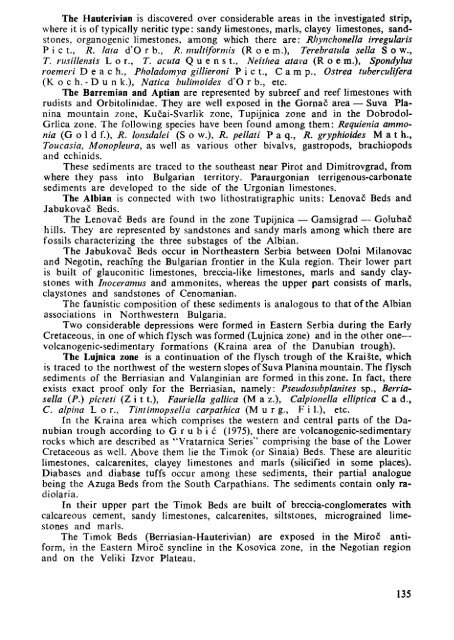THE MEDITERRANEAN LOWER CRETACEOUS
THE MEDITERRANEAN LOWER CRETACEOUS
THE MEDITERRANEAN LOWER CRETACEOUS
Create successful ePaper yourself
Turn your PDF publications into a flip-book with our unique Google optimized e-Paper software.
The Hauterivian is discovered over considerable areas in the investigated strip,<br />
where it is of typically neritic type: sandy limestones, marls, clayey limestones, sandstones,<br />
organogenic limestones, among which there are: Rhynchonella irregularis<br />
P i с t., R. lata d'Orb., R. multiformis (Roem.), Terebratula sella Sow.,<br />
T. rusillensis L о г., T. acuta Q u e n s t., Neithea atava (Roe m.), Spondylus<br />
roemeri D e a с h., Pholadomya gillieroni P i с t., Camp., Ostrea tuberculifera<br />
(К о с h. - D u n k.), Natica bulimoides d'O r b., etc.<br />
The Barremian and Aptian are represented by subreef and reef limestones with<br />
rudists and Orbitolinidae. They are well exposed in the Gornac area — Suva Planina<br />
mountain zone, Kucai-Svarlik zone, Tupijnica zone and in the Dobrodol-<br />
Grlica zone. The following species have been found among them: Requienia ammonia<br />
(Gold f.), R. lonsdalei (S о w.), R. pellati P a q., R. gryphioides Math.,<br />
Toucasia, Monopleura, as well as various other bivalvs, gastropods, brachiopods<br />
and echinids.<br />
These sediments are traced to the southeast near Pirot and Dimitrovgrad, from<br />
where they pass into Bulgarian territory. Paraurgonian terrigenous-carbonate<br />
sediments are developed to the side of the Urgonian limestones.<br />
The Albian is connected with two lithostratigraphic units: Lenovac Beds and<br />
Jabukovac Beds.<br />
The Lenovac Beds are found in the zone Tupijnica — Gamsigrad — GolubaS<br />
hills. They are represented by sandstones and sandy marls among which there are<br />
fossils characterizing the three substages of the Albian.<br />
The Jabukovac Beds occur in Northeastern Serbia between Dolni Milanovac<br />
and Negotin, reaching the Bulgarian frontier in the Kula region. Their lower part<br />
is built of glauconitic limestones, breccia-like limestones, marls and sandy claystones<br />
with Inoceramus and ammonites, whereas the upper part consists of marls,<br />
claystones and sandstones of Cenomanian.<br />
The faunistic composition of these sediments is analogous to that of the Albian<br />
associations in Northwestern Bulgaria.<br />
Two considerable depressions were formed in Eastern Serbia during the Early<br />
Cretaceous, in one of which flysch was formed (Lujnica zone) and in the other one—•<br />
volcanogenic-sedimentary formations (Kraina area of the Danubian trough).<br />
The Lujnica zone is a continuation of the flysch trough of the Kraiste, which<br />
is traced to the northwest of the western slopes of Suva Planina mountain. The flysch<br />
sediments of the Berriasian and Valanginian are formed in this zone. In fact, there<br />
exists exact proof only for the Berriasian, namely: Pseudosubplanites sp., Berriasella<br />
(P.) picteti (Z i 11.), Fauriella gallica (M a z.), Calpionella elliptica С a d.,<br />
C. alpina L о г., Tintinnopsella carpathica (M u г g., Fi 1.), etc.<br />
In the Kraina area which comprises the western and central parts of the Danubian<br />
trough according to G r u b i с (1975), there are volcanogenic-sedimentary<br />
rocks which are described as "Vratarnica Series" comprising the base of the Lower<br />
Cretaceous as well. Above them lie the Timok (or Sinaia) Beds. These are aleuritic<br />
limestones, calcarenites, clayey limestones and marls (silicified in some places).<br />
Diabases and diabase tuffs occur among these sediments, their partial analogue<br />
being the Azuga Beds from the South Carpathians. The sediments contain only radiolaria.<br />
In their upper part the Timok Beds are built of breccia-conglomerates with<br />
calcareous cement, sandy limestones, calcarenites, siltstones, micrograined limestones<br />
and marls.<br />
The Timok Beds (Berriasian-Hauterivian) are exposed in the Miroc antiform,<br />
in the Eastern Miroc syncline in the Kosovica zone, in the Negotian region<br />
and on the Veliki Izvor Plateau.<br />
135

















